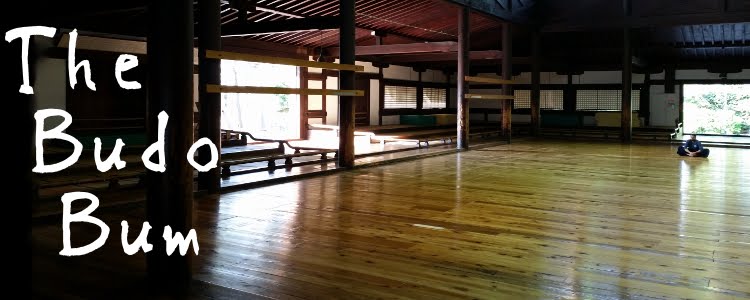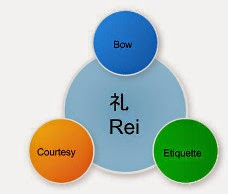 |
| Photo Copyright 2014 Grigoris Miliaresis |
残心
無心
不動心
中心
誠心
As much time as we spend on physical training, budo really isn’t about the techniques. It’s about the mind. We’ve got all these techniques and kata for training the body, but the sneaky secret is that these are training our minds at the same time. That list of words in Japanese above are all words having to do with the mind. The first 3, zanshin, mushin, and fudoshin are fairly common in the budo world.
What you’ll notice is that all of them include the character kokoro 心, which is read shin (sheen) when used in combination with other characters. Zanshin, mushin and fudoshin are all mental states. Zanshin, as I’ve written, is about staying aware. Mushin, which is usually translated as “no mind” and “fudoshin” which is often translated as “immoveable mind” are two more traits and states of awareness that are essential to development as a martial artist.
I’ll be honest, when I first encountered these ideas, reading about them in English left me more confused than enlightened. “Mushin means no mind.” I read that sentence, or one very like it, in at least a dozen different books. Not one of them really succeeded in communicating what this term means in martial arts. I have to admit as well, that the first several times I tried to read a translation of Takuan Soho’s Fudochi Shinmyo Ryoku, which is the major text on fudoshin, I read a lot of words but got nothing from them.
These are short words that describe sophisticated and subtle mental states that require a long time to develop and appreciate. The best I can do is try to explain how I understand them now. I hope my current understanding is worth something to others. At the same time I hope I can move further along the path of understanding these as I train. So if I come back in a year or 5 or 10 and say something different, don’t tell yell “But you said….” Congratulate me on furthering my understanding.
Mushin and fudoshin get described with some of the most contradictory language around. Mushin is written 無心, and literally translates as “no mind.” Fudoshin is written “不動心” which is probably best translated as “immovable mind,” but which Takuan describes by saying:
Although wisdom is described as immovable, this does not signify any insentient thing, like wood or stone. It moves as the mind is wont to move: forward or back, to the left, to the right, in the ten directions and to the eight points; and the mind that does not stop at all is called immovable wisdom.
Takuan Soho, The Unfettered Mind. William Scott Wilson translation
A mind that is no mind, and and immovable mind that does not stop at all. This kind of language makes no sense at all. At least it didn’t for my first decade or two of budo training. Mushin and fudoshin are mental states that are developed through hours and hours of training. Like most things having to do with our minds, these are complicated.
One of the first complications is that character for mind used in both mushin 無心 and fudoshin 不動心 that I pointed out at the beginning. The character 心 (pronounced “coe-coe-roe” and written kokoro in romaji) contains characteristics that in the Western tradition have been split in two. In English we talk about the mind as the seat of logic and intellect, and we talk about the heart as the seat of the emotions.
The Japanese don’t make the mistake of trying to separate the intellect and the emotions. They recognize that these are not separate things, but two parts of a greater whole. Intellect informs emotions, and emotions affect intellect. This should be obvious, but our cultural inheritance obscures it. When we talk about mushin and fudoshin though, we are definitely talking about both the intellectual and the emotional parts of us. We just don’t have a word in English that encompasses all of this.
Mushin means “no mind.” That’s pretty unimaginable. No mind? Isn’t that like being in a coma? No, it’s not, and that’s the problem I have with the term mushin. It’s not about being mindless. It may be closer to the way people are using the term “mindful” lately, but that’s not a descriptor either. Mushin has several layers to it, but I think it can be understood, even when you still have thousands of hours of training to go before you can consistently achieve it.
Mushin starts, not with no mind, but with a calm, clear mind that doesn’t impose itself. That’s the first step. Let your mind be quiet so it’s not imposing assumptions on the situation, and not trying to force any particular course. If you are making assumptions about your opponent or if you insist on following a particular course in the middle of a fight, you’re in trouble long before you close the ma’ai.
 |
| Photo Copyright 2014 Grigoris Miliaresis |
Calm down, relax, breath (remember how I said that “All I teach is how to breathe and how to walk?). Be calm and let yourself see, hear and feel the entire situation. Instead of making a plan and figuring out what to do, just be there. When people talk about “no mind” the idea is to let the conscious, chattering, clutter of thoughts go and just be there. It’s not that you have no mind, but that you let go of the mile-a-minute constant chatter of unconsidered thought that modern life encourages and makes so difficult to escape. Mushin is impossible when you’re always on the smart phone and surfing the web and listening to the radio or watching television all at the same time. You have to loosen the grip of those things on your mind before you can quiet it.
If you have to have things from outside stimulating your mind all the time, it can never calm down enough to approach mushin. Once you let go of all that though, and your mind calms down, then you can work on mushin. It’s complicated though, because mushin in budo also demands a fairly high level of technical mastery. If you have to think about any aspect of your technique, then you’re not at mushin. This means that mushin in conflict can only be achieved after you acquire sufficient technical skill that you can act without thinking about any part of the action.
The good news is that you can work on the mental and the technical sides of the problem. Take some time to unplug and turn off the electronic chatter. Get used to the sound of your own breathing and become comfortable with not chasing every thought and stimulus that you encounter. Lose the litany of what ifs.
Once you quiet your mind, you can start to get to mushin. For me, part of mushin is a deep layer of consciousness that isn’t influenced by all the little thoughts. This the layer of mind you want to be working with. It’s still and calm and smooth. It lets you reflect a situation accurately without imposing yourself on it. If you don’t impose your ideas and assumptions, you can act appropriately for the situation. A quiet mind can respond to what is really happening instead of to a preconceived assumption.
 |
| Calm and relaxed. Photo Copyright 2014, Girgoris Miliaresis |
When people write that mushin means “no mind” the immediate impression is that mushin is about not having an intellectual mind. It is just as much about not being emotionally active as it is about not being intellectually active. The intellectual mind has to quiet and relax, become calm and still. The emotions have to become calm as well. Until you can quiet the emotional side of your mind as well as the intellectual, you won’t have mushin.
Trash talk is common because many people never learn to let the emotional side of their heart/mind calm down and become still. Again, breathe and stop hanging on to your emotions. It’s not that you don’t have emotions. That’s not what mushin means. Your emotions don’t color the situation. Your ego can say you shouldn’t let this women push you around, or that that guy is a pipsqueak, or those folks deserve a comeuppance. All that just gets in the way of clear perception and can make you react to things that aren’t really there instead of responding to the situation, to the world, as it really is.
Our emotions and thoughts will run us ragged if we let them, with thoughts flittering from politics to friends to work to the lousy roads to the beautiful sunset to the song on the radio to the guy who just cut us off to the hot car going in the other direction to….
The heart/mind can go nonstop as long as you’re awake if you allow it. Letting it go takes practice. I was going to say it takes effort, but that’s the wrong direction. You’re not fighting with yourself. You’re just not clinging to the surface chatter. It’s not easy, especially now that we have devices to entertain us 24 hours a day. The first step is to allow yourself to not be entertained all the time. If you’re always distracted by TV or radio or the internet or Facebook, you never have the opportunity to develop mushin.
Oddly, the more you let go of the chatter and the distractions, the less you want them. It was probably easy 150 years ago with no TV or radio or MP3 players or even record players. Everything was relatively quiet and distractions were exciting because they were so rare and added some spice to life rather than distracting us from living it.
Mushin isn’t the absence of a heart/mind. The intellect and the emotions are still there. They aren’t the big show though. Once the intellect and the emotions are quiet and calmed, your mind can smoothly see the world as it is and you can respond to reality rather than all the chatter going on. Mushin is the absence of your ideas and emotions being imposed on your perception of the world.
I'd planned on writing about fudoshin in this post too, but I ended up with more than I expected about mushin, so I guess that will wait for now.



